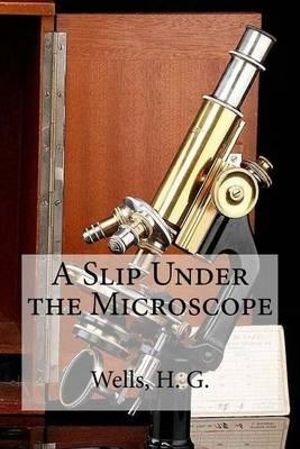“A Slip Under the Microscope” is a short story by the English author H. G. Wells (1866–1946), first published in the Yellow Book in 1896 and reprinted in The Plattner Story and OthersCollection of 17 short stories by H. G. Wells, first published in 1897. (1897) and The Country of the Blind and Other StoriesCollection of 33 short stories by H. G. Wells, first published in 1911. (1911).[1] The story, as recounted by an unidentified third-person narrator, tells of the ethical dilemma faced by a student who inadvertently cheats during his botany exam.
Synopsis
Hill, the son of a cobbler, has won a scholarship to the College of Science in South Kensington, London, one of the few institutes of higher education at that time to admit female students.[a]London University began admitting women to degree courses in 1878, but Oxford did not do so until 1920, and Cambridge until 1948.[2] Although feeling himself socially inferior to the rest of his class, whose parents are rich enough to have paid for their children’s’ education, Hill finds himself increasingly attracted to a fellow student, Miss Haysman, who “descended inconceivable social altitudes to speak to him”.
Hill does well in his first examination, coming second to Wedderburn, the son of an eminent eye specialist, whom he begins to see as a rival for Miss Haysman’s affections. Hill resolves to impress her by coming top in their next exam.
Determined that he should “demolish Wedderburn in the forthcoming examination and outshine him in the eyes of Miss Heysman”, Hill works exceedingly hard to do just that. The exam is held over two days, a written paper on the first and a practical examination on the second. One of the questions asks the students to examine a preparation laid out under a microscope, sketch it, and write down what they believe it to be. The preparation is covered by a glass slip, and a note on the bench states that the slip must not be moved. But out of sheer habit, after adjusting the mirror to get a better view, Hill inadvertently moves the slip. He hurriedly returns it to its original position, and sits “paralysed with astonishment at his action”. Hill is certain that no one has witnessed his act, but is torn by what to do. Should he simply not answer the question? What if Wedderburn had also moved the slip? Consumed by his desire to beat Wedderburn, Hill completes the question without owning up.
Hill finishes top, with Wedderburn this time in second place, but consumed by doubts Hill resolves to make a clean breast of it to Professor Binden, who had set the examination. As a scholarship student, Hill is not asked to sit down, and makes his confession standing before the professor’s desk. He expects that the marks for the one question will be deducted from his result, but Professor Binden is adamant that cheating is cheating, and that although owning up does him credit, Hill will now fail the examination, ending his scholastic career, as his scholarship will not be renewed.
Next day Hill’s place in the classroom is vacant, and the rumour of his having cheated begins to spread; Wedderburn’s view is “… what can you expect? His father is a cobbler.” But Miss Haysman refuses to believe it: “I will not believe it until he has told me so himself – face to face. I would scarcely believe it then.”
Commentary
The professor of English literature, Cedric Watts, has commented that the term slip in the title is “aptly ambiguous”, as it refers to the glass slip covering the specimen on the microscope slide and the blunder made by Hill.[3]
There are certain autobiographical elements to “A Slip Under the Microscope”. Wells himself won a scholarship to what was then known as the Normal School of Science, where the story is set,[b]The Normal School of Science was founded in 1881, and changed its name to the Royal College of Science in 1890. It is now part of Imperial College London.[2] but failed his final examinations after his interest switched to the organisation of society.[4]
See also
- H. G. Wells bibliographyList of publications written by H. G. Wells during the more than fifty years of his literary career.
Notes
| a | London University began admitting women to degree courses in 1878, but Oxford did not do so until 1920, and Cambridge until 1948.[2] |
|---|---|
| b | The Normal School of Science was founded in 1881, and changed its name to the Royal College of Science in 1890. It is now part of Imperial College London.[2] |
References
Bibliography
External links
- Full text of “A Slip Under the Microscope” at Project Gutenberg

